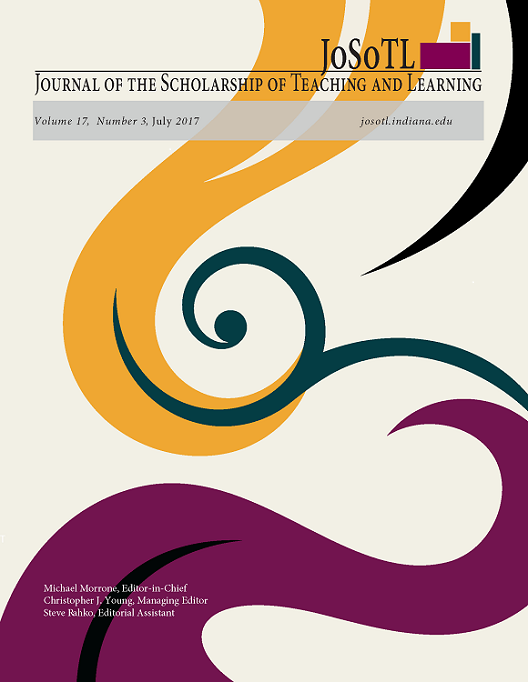Thinking as a Student: Stimulating Peer Education in the Humanities with an Undergraduate Teaching Assistant
Main Article Content
Abstract
In this article, I argue that peer educational experiences should be incorporated into the undergraduate humanities classroom by providing a case study of a successful Undergraduate Teaching Assistant (UTA) pilot. In keeping with Topping & Ehly’s (2001) criteria for successful peer education, I assigned the UTA a significant role in direct instruction. Partly owing to the UTA’s active classroom role, the experience enhanced learning for students and helped me create a dynamic, critically-engaged class environment. The experience also provided an opportunity for the UTA to engage in deep learning and develop a professional identity; near the end of this article, the UTA shares his reflection about the experience.
Downloads
Article Details
- Authors retain copyright and grant the Journal of the Scholarship of Teaching and Learning (JoSoTL) right of first publication with the work simultaneously licensed under a Creative Commons Attribution License, (CC-BY) 4.0 International, allowing others to share the work with proper acknowledgement and citation of the work's authorship and initial publication in the Journal of the Scholarship of Teaching and Learning.
- Authors are able to enter separate, additional contractual agreements for the non-exclusive distribution of the journal's published version of the work (e.g., post it to an institutional repository or publish it in a book), with an acknowledgement of its initial publication in the Journal of the Scholarship of Teaching and Learning.
- In pursuit of manuscripts of the highest quality, multiple opportunities for mentoring, and greater reach and citation of JoSoTL publications, JoSoTL encourages authors to share their drafts to seek feedback from relevant communities unless the manuscript is already under review or in the publication queue after being accepted. In other words, to be eligible for publication in JoSoTL, manuscripts should not be shared publicly (e.g., online), while under review (after being initially submitted, or after being revised and resubmitted for reconsideration), or upon notice of acceptance and before publication. Once published, authors are strongly encouraged to share the published version widely, with an acknowledgement of its initial publication in the Journal of the Scholarship of Teaching and Learning.
References
Baisinger, W., Peterson, G., & Spillman, B. (1984). Undergraduates as Colleagues: Using Undergraduates as Teaching Assistants in the Basic Course. Association for Communication Administration Bulletin, 47, 60-63.
Bernstein, D. (1979). Reliability and Fairness of Grading in a Mastery Program. Teaching of Psychology, 6(2), 104- 110.
Bichy, C. & O’Brien E. (2014). Course Redesign: Developing Peer Mentors to Facilitate Student Learning. Learning Assistance Review, 19(2), 43-57.
Cook, J. (2002, November). Undergraduate Teaching Assistants: The Relationship between Credibility and Learning in the Basic Communication Course. Paper presented at the 88th Annual Meeting of the National Communication Association, New Orleans, LA.
Eby. K, & Gilbert P. (2000). Implementing New Pedagogical Models: Using Undergraduate Teaching Assistants in a Violence and Gender Learning Community. Innovative Higher Education, 25 (2), 127-142.
Fernald, P. Chiseri, M. Lawson, D, Scroggs, G. & Jeanne C. Riddell, J. (1975). Systematic Manipulation of Student Pacing, the Perfection Requirement, and Contact with a Teaching Assistant in an Introductory Psychology Course. Teaching of Psychology, 2(4), 147-151.
Fingerson, L., & Culley, A. (2001). Collaborators in Teaching And Learning: Undergraduate Teaching Assistants in the Classroom. Teaching Sociology, 29(3), 299-315.
Fremouw, W., Millard, J & Donahoe, J. (1979). Learning-Through-Teaching: Knowledge Changes in Undergraduate Teaching Assistants. Teaching of Psychology 6(1), 30-33.
Gordon, J., Henry, P., & Dempster, M. (2013). Undergraduate Teaching Assistants: A LearnerCentered Model for Enhancing Student Engagement in the First-Year Experience. International Journal of Teaching and Learning in Higher Education, 25(1), 103-109.
Haskey, Brandon. (Host and interviewer). (2015, November 14). “The Academic Pot of Gold” Scrawl Radio, De Paul University Chicago, IL.
LaPlant, J. (2010). Peer Mentoring in Undergraduate Research. Council on Undergraduate Research Quarterly, 3(2), 5-6.
Mason, A. & Chandralekha, S. (2010). Using Reflection with Peers to Help Students Learn Effective Problem Solving Strategies. AIP Conference Proceedings, 1289(1), 41-44.
McCormick, K. & Shofner, M. (2010). Here Comes Everybody: An Epistemic Approach to Teaching Ulysses in a Small College. Pedagogy, 10(2), 363-388.
McNall, S. (1975). Peer Teaching: A Description and Evaluation. Teaching Sociology, 2(2), 133-146.
Mendenhall M. & Burr, W. (1983). Enlarging the Role of the Undergraduate Teaching Assistant. Teaching of Psychology, 10(3), 184-186.
Murray, J. (2015). Merging Teaching Practicum, Leadership Seminar, and Service Learning Merging Teaching Practicum, Leadership Seminar, and Service Learning. Journal of the Scholarship of Teaching & Learning, 15 (6), 63-77.
Socha, T. (1998). Developing an Undergraduate Teaching Assistant Program in Communication: Values, Curriculum, and Preliminary Assessment. Journal of the Association for Communication Administration, 27(2), 77-83.
Smith, T. (2008). Integrating Undergraduate Peer Mentors into Liberal Arts Courses: A Pilot Study. Innovative Higher Education, 33(1), 49-63.
Streitwieser, B., & Light, G. (2005). Undergraduates Leading Undergraduates: Peer Facilitation in a Science Workshop Program. Innovative Higher Education, 30(4) 269-288.
Tompkins, J. (1990). Pedagogy of the Distressed. College English, 52(6), 653-660.
Topping, K., & Ehly, S. (2001). Peer assisted learning: A framework for consultation. Journal of Educational and Psychological Consultation, 12, 113–132.
Trimble, R. & Carter, C. (1980). Test anxiety workshops using undergraduates as leaders. Personnel and Guidance Journal, 59(3), 173-175.
